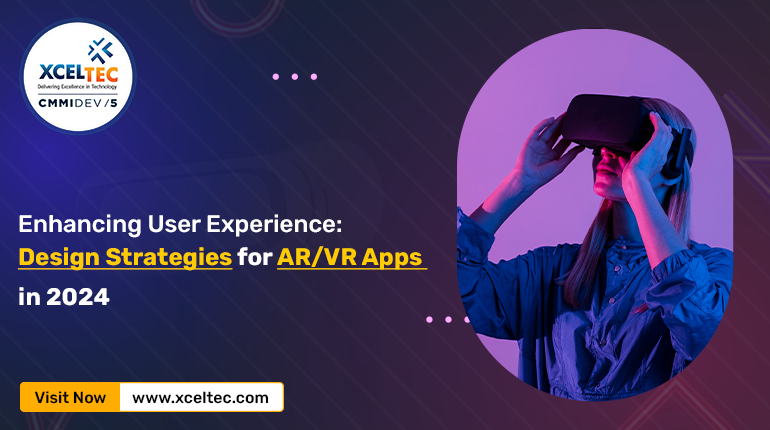The world of augmented reality (AR) and virtual reality (VR) has evolved significantly, and as we step into 2024, the potential for immersive experiences is greater than ever. To create compelling AR/VR applications that resonate with users, designers need to employ innovative strategies that enhance usability, engagement, and overall user experience. Here are some cutting-edge design strategies for AR/VR apps in 2024.
1. User-Centric Design
Empathy and User Research
Understanding the user’s needs, preferences, and pain points is critical. Conducting comprehensive user research through surveys, interviews, and usability testing helps create experiences that are intuitive and satisfying. Empathy graphs and personas can guide designers in user reactions and adjust the experience properly.
Accessibility and Inclusivity
Designing for a diverse audience means considering various physical abilities and ensuring the application is accessible to everyone. Features like voice commands, adjustable text sizes, and customizable controls can make AR/VR experiences more enjoyable for all.
2. Intuitive Interactions
Natural User Interfaces (NUI)
Utilize NUIs to create more natural and intuitive interactions. Movement controls, eye tracking, and voice commands can make navigating AR and VR environments seamless and more engaging. These interactions should feel like an extension of the user’s body, reducing the learning shape and increasing immersion.
Haptic Feedback
In virtual reality, haptic feedback can greatly improve the sense of presence. Advanced haptic devices can simulate textures, impacts, and vibrations, providing a more tangible and realistic experience. This sensory feedback helps ground users in the virtual environment, making interactions more believable.
3. Spatial Awareness and Contextual Design
Spatial Anchors and Persistent Content
Using physical anchors allows digital content to remain fixed in the real world, providing a consistent AR experience. This is crucial for applications in education, navigation, and industrial training, where users need reliable and repeatable interactions with virtual objects in a physical space.
Context-Aware Content
Design content that responds to the user’s environment and context. For example, an AR navigation app should adapt to different lighting conditions and provide relevant information based on the user’s location. Context-aware design has become more popular and useful in AR/VR applications.
4. Immersive Storytelling
Narrative-Driven Experiences
Crafting can engage users. Whether it’s a VR game or an AR educational app, integrating scene elements can make the experience more memorable and impactful. Storyboarding and scriptwriting are essential skills for designers to create coherent and captivating narratives.
Interactive and Adaptive Stories
Engagement can allow users to influence the story through their actions and increase activities. Dynamic stories and adaptive narratives respond to user decisions, providing a personalized experience that can lead to multiple conclusions.
5. Performance Optimization
Efficient Rendering Techniques
Optimizing the performance of an AR/VR developer is crucial for a smooth experience. Techniques like level of detail (LOD) adjustments, the exclusion process, and foveated graphics can help maintain high frame rates while enhancing user comfort.
Edge Computing and Cloud Integration
Outsourcing processing work, edge computing, and cloud services can enhance performance and enable more intricate and data-intensive applications. This method can guarantee quick interactions, which may help real-time communication in AR/VR environments.
6. User Safety and Comfort
Ergonomic Design
Consider the practicality of using AR/VR devices. Design interfaces and interactions that reduce program and user discomfort, ensuring users can engage with the application for extended periods. Adjustable virtual environments and customizable user interfaces can cater to different user preferences and physical capabilities.
7. Continuous Improvement and User Feedback
Iterative Design Process
Use an iterative approach to design that requires user input to be taken into account at each level. The program is continuously tested and refined in response to user feedback and connections so that it adjusts to user expectations and quickly fixes any problems.
Community Engagement
Creating a community around your AR/VR software can increase the customer base and offer insightful information. Designers can gain a better understanding of customer demands and make more informed design decisions by interacting with users through discussions, social media, and app feedback systems.
How XcelTec Helps You Integrate AI and Machine Learning in E-commerce Web Development
XcelTec can help you navigate the complexities of AR/VR development and achieve your goals. We specialize in integrating AI and Machine Learning technologies to enhance e-commerce operations. We tailor solutions for personalized shopping experiences, improved customer service through chatbots, optimized inventory management, fraud detection, dynamic pricing strategies, and enhanced user experiences.
Conclusion:
Embrace the transformative power of AI and Machine Learning with XcelTec to elevate your e-commerce platform, driving growth, efficiency, and customer satisfaction in the digital age.
Get in touch with us for more!
Contact us on:- +91 987 979 9459 | +1-980 428 9909
Email us at:- sales@xceltec.com
Visit our website: https://www.xceltec.com/


 :
: